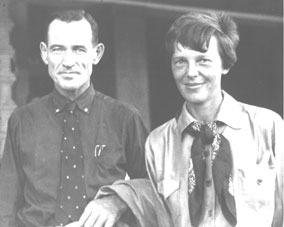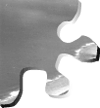 |
|
|
|
|
|
|
|
|
|
|
|
||
|
|
|
||
September 1997, page 34.
The analogy of the Earhart riddle to a giant jigsaw puzzle is one that we’ve used many times, and with good reason. Each documentable fact is a puzzle piece that must be fit correctly into the overall picture. Trouble is, the box cover has been lost and we don’t know what the picture is supposed to look like. To make matters worse, the pieces of our puzzle are mixed in with those of a hundred other puzzles and must be carefully sorted out before we try to fit them in. Where pieces are missing we have to guess, and we make mistakes. Meanwhile, onlookers jeer that we’re merely constructing a fictional picture from random shapes.
But piece by piece, always more slowly than we would wish, the puzzle comes together. As more and more facts replace guesses and speculation, the gaps are filled in and connections are made. We still have to guess and we still make mistakes, but the picture grows more and more solid and the naysayers grow ever more nervous. And as anyone who has put together a jigsaw puzzle knows, the closer we get to the end, the faster it goes.
Let’s look at our new puzzle pieces ( in blue) and see how they fit with the ones we already had.
 When
the USS Colorado’s Senior Aviator, Lt. John Lambrecht, flew over
Nikumaroro on July 9, 1937 (one week after the disappearance) he reported
that “signs of recent habitation were clearly visible” but saw
no aircraft. The island had not been officially inhabited since 1892 but
Lambrecht didn’t know that. The search moved on. (U.S. Navy report dated
16 July 1937 “Aircraft Search For Earhart Plane.”)
When
the USS Colorado’s Senior Aviator, Lt. John Lambrecht, flew over
Nikumaroro on July 9, 1937 (one week after the disappearance) he reported
that “signs of recent habitation were clearly visible” but saw
no aircraft. The island had not been officially inhabited since 1892 but
Lambrecht didn’t know that. The search moved on. (U.S. Navy report dated
16 July 1937 “Aircraft Search For Earhart Plane.”)  Three
months later, British Colonial Service officers Henry E. Maude and Eric
R. Bevington paid a three-day visit to Nikumaroro with a delegation of Gilbertese
islanders to evaluate the atoll for future settlement. On a remote part
of the island Bevington noted “signs of previous habitation” which
he later described as looking like “someone had bivouaced for the night.”
(Eric R. Bevington, diary entry for October 14, 1937.)
Three
months later, British Colonial Service officers Henry E. Maude and Eric
R. Bevington paid a three-day visit to Nikumaroro with a delegation of Gilbertese
islanders to evaluate the atoll for future settlement. On a remote part
of the island Bevington noted “signs of previous habitation” which
he later described as looking like “someone had bivouaced for the night.”
(Eric R. Bevington, diary entry for October 14, 1937.)  On
the same part of the island indicated by Bevington, and where local tradition
held that bones had once been found, TIGHAR recovered the remains of an
American woman’s shoe dating from the mid-1930s which matched the size and
style worn by Earhart. A second, different heel indicated the presence of
another pair of shoes. Excavation of the site later revealed the ash and
charcoal of a campfire which contained a partially burned can label. (TIGHAR
archaeological investigations 1991 and 1997.)
On
the same part of the island indicated by Bevington, and where local tradition
held that bones had once been found, TIGHAR recovered the remains of an
American woman’s shoe dating from the mid-1930s which matched the size and
style worn by Earhart. A second, different heel indicated the presence of
another pair of shoes. Excavation of the site later revealed the ash and
charcoal of a campfire which contained a partially burned can label. (TIGHAR
archaeological investigations 1991 and 1997.)  Gallagher’s
documented discovery of human remains and artifacts on Nikumaroro in 1940
connects these pieces perfectly. Lambrecht’s impression was correct. There
was someone on the ground. Bevington was right. Someone had bivouaced there.
The legends about bones being found are true. And TIGHAR’s discoveries,
it turns out, had been preceded over half a century earlier by those of
Gallagher who had reached the same conclusion as to their origin.
Gallagher’s
documented discovery of human remains and artifacts on Nikumaroro in 1940
connects these pieces perfectly. Lambrecht’s impression was correct. There
was someone on the ground. Bevington was right. Someone had bivouaced there.
The legends about bones being found are true. And TIGHAR’s discoveries,
it turns out, had been preceded over half a century earlier by those of
Gallagher who had reached the same conclusion as to their origin. These
pieces show a very clear picture of at least one and probably two individuals
marooned on the island sometime not earlier than about 1933 (mid-1930s
shoe heel) and not later than July 9, 1937 (Lambrecht’s “signs of
recent habitation”). One of them is probably an American woman who
wears the same style and size shoe as Amelia Earhart. They have very few
assets with which to survive, but they do have a nautical sextant with
an inverting eyepiece useful in taking sightings from an airplane. They
also have a liqueur bottle and some canned food. No yachts are known to
have sunk or disappeared in the area in those years. No means for castaways
to come ashore (raft, flotation device, etc.) was ever reported found.
The only known missing persons of European decent in the region are Amelia
Earhart and Fred Noonan. The part of the puzzle that shows what happened
to the airplane is less clear and more speculative, and yet a number of
pieces seem to fit together.
These
pieces show a very clear picture of at least one and probably two individuals
marooned on the island sometime not earlier than about 1933 (mid-1930s
shoe heel) and not later than July 9, 1937 (Lambrecht’s “signs of
recent habitation”). One of them is probably an American woman who
wears the same style and size shoe as Amelia Earhart. They have very few
assets with which to survive, but they do have a nautical sextant with
an inverting eyepiece useful in taking sightings from an airplane. They
also have a liqueur bottle and some canned food. No yachts are known to
have sunk or disappeared in the area in those years. No means for castaways
to come ashore (raft, flotation device, etc.) was ever reported found.
The only known missing persons of European decent in the region are Amelia
Earhart and Fred Noonan. The part of the puzzle that shows what happened
to the airplane is less clear and more speculative, and yet a number of
pieces seem to fit together.  Badly
damaged airplane components which appear to be from the Earhart aircraft
have been found in the island’s abandoned village and were clearly brought
there from somewhere else. The section of aircraft skin (Artifact 2-2-V-1)
is believed to be part of a patch known to have been installed on the belly
of the Electra under the forward part of the cabin. For the sheet of aluminum
to have been removed, the aircraft had to be either standing on its gear
or lying on its back. (TIGHAR archaeological investigations 1989, 1991 and
1996.)
Badly
damaged airplane components which appear to be from the Earhart aircraft
have been found in the island’s abandoned village and were clearly brought
there from somewhere else. The section of aircraft skin (Artifact 2-2-V-1)
is believed to be part of a patch known to have been installed on the belly
of the Electra under the forward part of the cabin. For the sheet of aluminum
to have been removed, the aircraft had to be either standing on its gear
or lying on its back. (TIGHAR archaeological investigations 1989, 1991 and
1996.)  The
most credible post-loss radio message with intelligible content includes
the fragmentary phrases: 281 NORTH HOWLAND...CALL KHAQQ...BEYOND NORTH...WON’T
HOLD WITH US MUCH LONGER...ABOVE WATER...SHUT OFF. It seems reasonable to
speculate that, if authentic, this message indicates that the aircraft is
somehow threatened by rising water. (Message reported by U.S. Navy Radio,
Wailupe, Hawaii, July 4, 1937.)
The
most credible post-loss radio message with intelligible content includes
the fragmentary phrases: 281 NORTH HOWLAND...CALL KHAQQ...BEYOND NORTH...WON’T
HOLD WITH US MUCH LONGER...ABOVE WATER...SHUT OFF. It seems reasonable to
speculate that, if authentic, this message indicates that the aircraft is
somehow threatened by rising water. (Message reported by U.S. Navy Radio,
Wailupe, Hawaii, July 4, 1937.)  When
the USS Colorado’s Senior Aviator, Lt. John Lambrecht, flew over Nikumaroro
on July 9, 1937 (one week after the disappearance) he reported that “signs
of recent habitation were clearly visible” but saw no aircraft. (U.S.
Navy report dated 16 July 1937 "Aircraft Search For Earhart Plane.")
When
the USS Colorado’s Senior Aviator, Lt. John Lambrecht, flew over Nikumaroro
on July 9, 1937 (one week after the disappearance) he reported that “signs
of recent habitation were clearly visible” but saw no aircraft. (U.S.
Navy report dated 16 July 1937 "Aircraft Search For Earhart Plane.")  A
detailed survey of Nutiran district by New Zealand authorities in late 1938/early
1939 found no aircraft debris present at that time. (New Zealand Pacific
Island Survey, Gardner Island, report dated 28 March 1939.)
A
detailed survey of Nutiran district by New Zealand authorities in late 1938/early
1939 found no aircraft debris present at that time. (New Zealand Pacific
Island Survey, Gardner Island, report dated 28 March 1939.)  The
two anecdotal accounts of airplane wreckage seen by former residents of
Nikumaroro in the late 1950s strongly suggest debris traveling from seaward
toward the shore and, in some cases, through the lagoon passage. (Interviews
on Funafuti, Tuvalu in March 1997.)
The
two anecdotal accounts of airplane wreckage seen by former residents of
Nikumaroro in the late 1950s strongly suggest debris traveling from seaward
toward the shore and, in some cases, through the lagoon passage. (Interviews
on Funafuti, Tuvalu in March 1997.)  Aerial
photos taken in 1953 and 1988 tend to corroborate the anecdotal accounts
of aircraft wreckage on the reef flat and beach. (Aerial mapping photos,
1953. RNZAF photo, 1988.)
Aerial
photos taken in 1953 and 1988 tend to corroborate the anecdotal accounts
of aircraft wreckage on the reef flat and beach. (Aerial mapping photos,
1953. RNZAF photo, 1988.)  The
recovery in 1971 of an R1340 engine from the reef flat off the western end
of an atoll in the Phoenix Group may have taken place on Nikumaroro. (Anecdotal
account, March 1997.)
The
recovery in 1971 of an R1340 engine from the reef flat off the western end
of an atoll in the Phoenix Group may have taken place on Nikumaroro. (Anecdotal
account, March 1997.)  A
photograph showing what may be a badly wrecked Lockheed 10E in a Pacific
island setting may have been taken on Nikumaroro. The starboard engine missing
in the photo may be the one recovered from the reef flat. (Photo of uncertain
origin.)
A
photograph showing what may be a badly wrecked Lockheed 10E in a Pacific
island setting may have been taken on Nikumaroro. The starboard engine missing
in the photo may be the one recovered from the reef flat. (Photo of uncertain
origin.)  The
picture formed by these pieces seems to show an airplane that was landed
successfully on the reef flat, sent radio distress calls for a short time,
but was washed off the edge of the reef or into one of the many crevasses
that penetrate the reef flat. The crew may have been forced to abandon the
aircraft and make for the beach with what few essentials they could carry.
The wreck seems to have lain undetected for years until storm activity broke
it up and began washing pieces shoreward. The wreckage should still be there
although now buried in the sand or hidden in the nearly impenetrable beachfront
vegetation.
The
picture formed by these pieces seems to show an airplane that was landed
successfully on the reef flat, sent radio distress calls for a short time,
but was washed off the edge of the reef or into one of the many crevasses
that penetrate the reef flat. The crew may have been forced to abandon the
aircraft and make for the beach with what few essentials they could carry.
The wreck seems to have lain undetected for years until storm activity broke
it up and began washing pieces shoreward. The wreckage should still be there
although now buried in the sand or hidden in the nearly impenetrable beachfront
vegetation. 